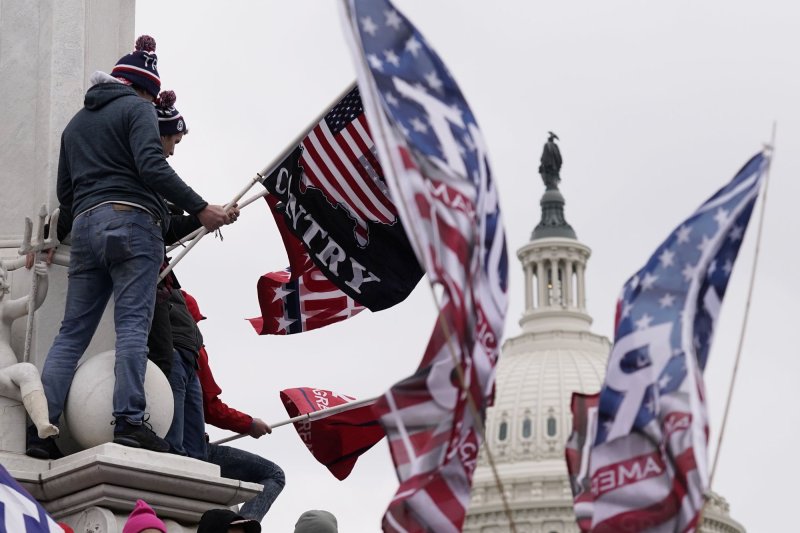One in three Iraq/Afghanistan veterans sees extremizing their ranks
"Since 9/11, we've seen a shift from plots and attacks by religious extremists to those perpetrated by groups advancing political grievances," retired Marine Corps Lt. Col. Joe Plenzler says in his prepared testimony.
Daniel Uria & Linus Hoeller, Medill News Service

Radical supporters of former President Donald Trump riot at the U.S. Capitol on January 6 in a violent effort to keep him in power and prevent the election of Joe Biden. File Photo by Ken Cedeno/UPI | License Photo
Oct. 13 (UPI) -- More than one in three Afghanistan and Iraq veterans said they perceived extremism as existing within the military and within the veteran community, the head of a veterans' organization told the House veterans affairs committee hearing on Wednesday.
According to an ongoing survey of over 3,500 former military members by the Iraq and Afghanistan Veterans of America, more than one-third of the veterans also said they have directly experienced extremism, IAVA CEO Jeremy Butler told the committee.
House lawmakers convened the hearing -- titled "Domestic Violent Extremist Groups and the Recruitment of Veterans" -- to examine concerns about a rising number of military veterans joining dangerous and potentially violent domestic extremist groups, like the far-right Proud Boys and Oath Keepers.
The hearing comes amid a widespread government review of domestic extremism following the Jan. 6 attack at the U.S. Capitol, which resulted in the arrests and prosecutions of hundreds of rioters -- some of whom were active and former military members.
RELATED FBI official says domestic terror threats more than twice as high as international threats
In February, Defense Secretary Lloyd Austin ordered a military-wide stand down for 60 days to deal with extremism in military ranks, and a Pentagon report in March warned that service members are highly prized recruiting targets by White supremacists and other extremist groups as a means to "bring legitimacy to their causes and enhance their ability to carry out attacks."
Veterans are particularly sought after by domestic terrorist groups because of their skillsets -- tactical knowledge, connections, communication and weapons skills, among others. The veterans can be vulnerable targets, particularly as they transition back to civilian life, searching for a sense of purpose or feeling betrayed by the government.
Cynthia Miller-Idriss of American University said that terrorist organizations seek to convert a feeling of betrayal by the government into violence that is framed as a "heroic action of patriotism for the 'true nation.'"
Butler and Miller-Idriss testified at the hearing along with several threat and security experts, retired Marine Corps Lt. Col. Joe Plenzler, photojournalist Joel Beeson and Anti-Defamation League Vice President Oren Segal.
Plenzler said veteran recruitment should be taken seriously because 10% of domestic terror since 2015 has links to veterans while they make up about 6% of the population.
"The threats are real and we are all at risk," he said. "They breached the security of this building and hunted. They hunted for you."
Segal, a leader of the ADL's Center on Extremism, said in prepared testimony that out of 357 people arrested for the Capitol attack, four were active military and 39 were veterans.
"With 18 million veterans in the United States, it is inevitable that some of them will be extremists," Segal said in his opening statement.
"Anecdotally, one can easily find veterans among the membership of a variety of right-wing extremist groups, from White supremacist neo-Nazis to anti-government militia groups."
Some Republican committee members took issue with holding the hearing.
Rep. Jim Banks, R-Ind., said it was "offensive" that Chairman Rep. Mark Takano, D.-Calif., considered himself the person who would "save the veterans" and accused Democrats of seeing veterans as broken people and extremists. He questioned the impartiality and authority of the witnesses.
"Frankly, sir, this is the problem," Butler countered. "The questions you are asking are part of the problem here. We are using lies ... to avoid addressing the real issues this country is facing."
In an interview later, Plenzler said he "whole-heartedly" agreed with Butler's criticism of politically motivated questioning.
Rep. Matt Rosendale, R.-Md., pressed the experts to equate the actions of the Jan. 6 insurrection with those of Black Lives Matter protesters, a line of questioning that was quickly shut down by Plenzler.
"It's one thing if someone burns down a Walmart, another ... if someone attacks the nation's Capitol," he said. One was an attack on commerce, the other "an attack on the Constitution."
According to Plenzler, 71 of the people arrested in relation with the insurrection had military ties.
"The light is blinking red on the dashboard, so we need to look under the hood and investigate this," he said.
Butler said it's critical for the Pentagon to properly screen all recruits.
He also said educating veterans about extremist recruitment as they leave military service is important -- as is understanding why some of them ultimately fall under the spell of extremist militia-type groups like the Three Percenters and Boogaloo Bois.

"Groups and movements desire and anticipate a breakdown of civil society and the existing governmental structure -- and are seeking to position themselves to not only take advantage of such a dystopian scenario, but to actually help instigate this breakdown," threat expert Cynthia Miller-Idriss said in her testimony Wednesday. File Photo by Ken Cedeno/UPI
Heidi Beirich, co-founder and chief strategy officer at the Global Project Against Hate and Extremism, says veterans and active-duty members make up roughly a quarter of extremist rosters.
"This is not an accident," she said in prepared remarks. "These groups spend considerable time reaching out to the community.
"There is no question that the major terrorism threat to the U.S. is coming from the far right. There was no greater display of this than the events of Jan. 6 ... where extremists of various stripes -- White supremacists, neo-Nazis, anti-government ideologues and conspiracists -- joined forces to storm our Capitol."
Plenzler said "terrorist organizations use sophisticated recruiting, communication and indoctrination methods to attract followers, provide them a sense of community and purpose and incite them to violence," he says in his prepared testimony.
"Since 9/11, we've seen a shift from plots and attacks by religious extremists to those perpetrated by groups advancing political grievances.
"Violent extremists weaponize influence by preying on the human brain's sensitivity to appeals to scarcity, sanction and fear, consistency, altruism and reward."
Seth Jones, an expert at the Center for Strategic and International Studies, says in his testimony that it's no coincidence that many of the best-known domestic terrorists -- including Oklahoma City bomber Timothy McVeigh, Atlanta Olympic bomber Eric Rudolph and Ruby Ridge extremist Randy Weaver -- were at one time members of the U.S. Armed Forces.
"In October 2020, the FBI arrested Adam Fox, Barry Croft and several other accomplices in a plot to kidnap and potentially execute Michigan Gov. Gretchen Whitmer," he said in prepared remarks. "Violent far-right and far-left networks have solicited military personnel because of their skill sets."
A House select committee is still investigating the U.S. Capitol attack, which was carried out by radical supporters of former President Donald Trump in a bid to keep him in power.
"The past few years have witnessed an explosion of far-right violence and the normalization of the extremist ideas that drive it," Miller-Idriss said in prepared remarks.
"Unlike in prior generations, the vast majority of extremist content and radicalization today is experienced online," she adds.
"One of the most worrying trends is the increasing number of Americans who were not previously affiliated with any [extremist] groups but are now increasingly drawn into the large tent of the networked extreme far right."







:quality(70)/cloudfront-us-east-1.images.arcpublishing.com/mco/FKQ3BLEBDZBS3COXEQYEL3UI2Y.jpg)
:quality(70)/arc-anglerfish-arc2-prod-mco.s3.amazonaws.com/public/7WEWFP5NZFGGPK3RY2MI73JLRM.JPG)
:quality(70)/cloudfront-us-east-1.images.arcpublishing.com/mco/7ETVBPQ2VJGPDBAHNVEJLPNVAE.jpg)
:quality(70)/cloudfront-us-east-1.images.arcpublishing.com/mco/UC4E6XRRS5HCFJ5LH3OH2RHYRA.jpeg)
:quality(70)/arc-anglerfish-arc2-prod-mco.s3.amazonaws.com/public/XJAOJBTOBJBY5P7OJFUH37532U.jpg)
:quality(70)/cloudfront-us-east-1.images.arcpublishing.com/mco/E25H45N4IRANVHLA7D75VYRUBY.jpg)
:quality(70)/cloudfront-us-east-1.images.arcpublishing.com/mco/ENBQSPK42VEOJBQUUBP4CZ6TIM.jpg)
:quality(70)/cloudfront-us-east-1.images.arcpublishing.com/mco/EHLRFL7QDFDBNBYQ5EM2QYDTTI.jpg)


